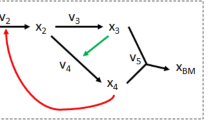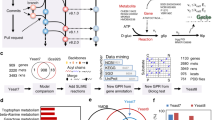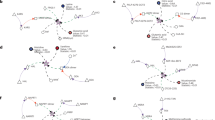Abstract
Over the past decade, a growing community of researchers has emerged around the use of constraint-based reconstruction and analysis (COBRA) methods to simulate, analyze and predict a variety of metabolic phenotypes using genome-scale models. The COBRA Toolbox, a MATLAB package for implementing COBRA methods, was presented earlier. Here we present a substantial update of this in silico toolbox. Version 2.0 of the COBRA Toolbox expands the scope of computations by including in silico analysis methods developed since its original release. New functions include (i) network gap filling, (ii) 13C analysis, (iii) metabolic engineering, (iv) omics-guided analysis and (v) visualization. As with the first version, the COBRA Toolbox reads and writes systems biology markup language–formatted models. In version 2.0, we improved performance, usability and the level of documentation. A suite of test scripts can now be used to learn the core functionality of the toolbox and validate results. This toolbox lowers the barrier of entry to use powerful COBRA methods.
This is a preview of subscription content, access via your institution
Access options
Subscribe to this journal
Receive 12 print issues and online access
$259.00 per year
only $21.58 per issue
Buy this article
- Purchase on Springer Link
- Instant access to full article PDF
Prices may be subject to local taxes which are calculated during checkout





Similar content being viewed by others
References
Feist, A.M. et al. Model-driven evaluation of the production potential for growth-coupled products of Escherichia coli. Metab. Eng. 12, 173–186 (2010).
Feist, A.M. & Palsson, B.O. The growing scope of applications of genome-scale metabolic reconstructions using Escherichia coli. Nat. Biotechnol. 26, 659–667 (2008).
Oberhardt, M.A., Palsson, B.O. & Papin, J.A. Applications of genome-scale metabolic reconstructions. Mol. Syst. Biol. 5, 320 (2009).
Covert, M.W., Knight, E.M., Reed, J.L., Herrgard, M.J. & Palsson, B.O. Integrating high-throughput and computational data elucidates bacterial networks. Nature 429, 92–96 (2004).
Gianchandani, E.P., Joyce, A.R., Palsson, B.O. & Papin, J.A. Functional states of the genome-scale Escherichia coli transcriptional regulatory system. PLoS Comput. Biol. 5, e1000403 (2009).
Brynildsen, M.P., Wong, W.W. & Liao, J.C. Transcriptional regulation and metabolism. Biochem. Soc. Trans. 33, 1423–1426 (2005).
Thiele, I., Fleming, R.M., Bordbar, A., Schellenberger, J. & Palsson, B.O. Functional characterization of alternate optimal solutions of Escherichia coli's transcriptional and translational machinery. Biophys. J. 98, 2072–2081 (2010).
Thiele, I., Jamshidi, N., Fleming, R.M. & Palsson, B.O. Genome-scale reconstruction of Escherichia coli's transcriptional and translational machinery: a knowledge base, its mathematical formulation, and its functional characterization. PLoS Comput. Biol. 5, e1000312 (2009).
Papin, J.A., Hunter, T., Palsson, B.O. & Subramaniam, S. Reconstruction of cellular signalling networks and analysis of their properties. Nat. Rev. Mol. Cell Biol. 6, 99–111 (2005).
Li, F., Thiele, I., Jamshidi, N. & Palsson, B.O. Identification of potential pathway mediation targets in Toll-like receptor signaling. PLoS Comput. Biol. 5, e1000292 (2009).
Hyduke, D.R. & Palsson, B.Ø. Towards genome-scale signalling-network reconstructions. Nat. Rev. Genet. 11, 297–307 (2010).
Raman, K., Vashisht, R. & Chandra, N. Strategies for efficient disruption of metabolism in Mycobacterium tuberculosis from network analysis. Mol. Biosyst. 5, 1740–1751 (2009).
Becker, S.A. & Palsson, B.O. Genome-scale reconstruction of the metabolic network in Staphylococcus aureus N315: an initial draft to the two-dimensional annotation. BMC Microbiol. 5, 8 (2005).
Bordbar, A., Lewis, N.E., Schellenberger, J., Palsson, B.O. & Jamshidi, N. Insight into human alveolar macrophage and M. tuberculosis interactions via metabolic reconstructions. Mol. Syst. Biol. 6, 422 (2010).
Thiele, I., Price, N.D., Vo, T.D. & Palsson, B.O. Candidate metabolic network states in human mitochondria. Impact of diabetes, ischemia, and diet. J. Biol. Chem. 280, 11683–11695 (2005).
Price, N.D., Reed, J.L. & Palsson, B.O. Genome-scale models of microbial cells: evaluating the consequences of constraints. Nat. Rev. Micro. 2, 886–897 (2004).
Becker, S.A. et al. Quantitative prediction of cellular metabolism with constraint-based models: the COBRA Toolbox. Nat. Protoc. 2, 727–738 (2007).
Notebaart, R.A., Teusink, B., Siezen, R.J. & Papp, B. Co-regulation of metabolic genes is better explained by flux coupling than by network distance. PLoS Comput. Biol. 4, e26 (2008).
Durot, M., Bourguignon, P.Y. & Schachter, V. Genome-scale models of bacterial metabolism: reconstruction and applications. FEMS Microbiol. Rev. 33, 164–190 (2009).
Raman, K., Yeturu, K. & Chandra, N. targetTB: a target identification pipeline for Mycobacterium tuberculosis through an interactome, reactome and genome-scale structural analysis. BMC Syst. Biol. 2, 109 (2008).
Vazquez, A. et al. Impact of the solvent capacity constraint on E. coli metabolism. BMC Syst. Biol. 2, 7 (2008).
Henry, C.S., Jankowski, M.D., Broadbelt, L.J. & Hatzimanikatis, V. Genome-scale thermodynamic analysis of Escherichia coli metabolism. Biophys. J. 90, 1453–1461 (2006).
Fleming, R.M., Thiele, I. & Nasheuer, H.P. Quantitative assignment of reaction directionality in constraint-based models of metabolism: application to Escherichia coli. Biophys. Chem. 145, 47–56 (2009).
Fleming, R.M. & Thiele, I. von Bertalanffy 1.0: a COBRA toolbox extension to thermodynamically constrain metabolic models. Bioinfomatics 27, 142–143 (2010).
Becker, S.A. & Palsson, B.O. Context-specific metabolic networks are consistent with experiments. PLoS Comput. Biol. 4, e1000082 (2008).
Shlomi, T., Cabili, M.N., Herrgard, M.J., Palsson, B.O. & Ruppin, E. Network-based prediction of human tissue-specific metabolism. Nat. Biotech. 26, 1003–1010 (2008).
Schellenberger, J. & Palsson, B.O. Use of randomized sampling for analysis of metabolic networks. J. Biol. Chem. 284, 5457–5461 (2009).
Orth, J.D., Thiele, I. & Palsson, B.O. What is flux balance analysis? Nat. Biotech. 28, 245–248 (2010).
Orth, J.D. & Palsson, B.Ø. Systematizing the generation of missing metabolic knowledge. Biotechnol. Bioeng. 107, 403–412 (2010).
Palsson, B. Metabolic systems biology. FEBS Lett. 583, 3900–3904 (2009).
Schellenberger, J., Park, J., Conrad, T. & Palsson, B. BiGG: a biochemical genetic and genomic knowledgebase of large scale metabolic reconstructions. BMC Bioinformatics 11, 213 (2010).
Palsson, B.O. Two-dimensional annotation of genomes. Nat. Biotechnol. 22, 1218–1219 (2004).
Reed, J.L., Famili, I., Thiele, I. & Palsson, B.O. Towards multidimensional genome annotation. Nat. Rev. Genet. 7, 130–141 (2006).
Feist, A.M. et al. A genome-scale metabolic reconstruction for Escherichia coli K-12 MG1655 that accounts for 1260 ORFs and thermodynamic information. Mol. Syst. Biol. 3 (2007).
Hong, S.H. et al. The genome sequence of the capnophilic rumen bacterium Mannheimia succiniciproducens. Nat. Biotech. 22, 1275–1281 (2004).
Mo, M., Palsson, B. & Herrgard, M. Connecting extracellular metabolomic measurements to intracellular flux states in yeast. BMC Syst. Biol. 3, 37 (2009).
Nogales, J., Palsson, B. & Thiele, I. A genome-scale metabolic reconstruction of Pseudomonas putida KT2440: iJN746 as a cell factory. BMC Syst. Biol. 2, 79 (2008).
Raghunathan, A., Reed, J., Shin, S., Palsson, B. & Daefler, S. Constraint-based analysis of metabolic capacity of Salmonella typhimurium during host-pathogen interaction. BMC Syst. Biol. 3, 38 (2009).
Nookaew, I. et al. The genome-scale metabolic model iIN800 of Saccharomyces cerevisiae and its validation: a scaffold to query lipid metabolism. BMC Syst. Biol. 2, 71 (2008).
Kuepfer, L., Sauer, U. & Blank, L.M. Metabolic functions of duplicate genes in Saccharomyces cerevisiae. Genome Res. 15, 1421–1430 (2005).
Gonzalez, O. et al. Reconstruction, modeling & analysis of Halobacterium salinarum R-1 metabolism. Mol. Biosyst. 4, 148–159 (2008).
Heinemann, M., Kummel, A., Ruinatscha, R. & Panke, S. In silico genome-scale reconstruction and validation of the Staphylococcus aureus metabolic network. Biotechnol. Bioeng. 92, 850–864 (2005).
Thiele, I. & Palsson, B.O. A protocol for generating a high-quality genome-scale metabolic reconstruction. Nat. Protocols 5, 93–121 (2010).
Smallbone, K. & Simeonidis, E. Flux balance analysis: a geometric perspective. J. Theor. Biol. 258, 311–315 (2009).
Satish Kumar, V., Dasika, M. & Maranas, C. Optimization based automated curation of metabolic reconstructions. BMC Bioinformatics 8, 212 (2007).
Burgard, A.P., Pharkya, P. & Maranas, C.D. Optknock: a bilevel programming framework for identifying gene knockout strategies for microbial strain optimization. Biotechnol. Bioeng. 84, 647–657 (2003).
Patil, K., Rocha, I., Forster, J. & Nielsen, J. Evolutionary programming as a platform for in silico metabolic engineering. BMC Bioinformatics 6, 308 (2005).
Lun, D.S. et al. Large-scale identification of genetic design strategies using local search. Mol. Syst. Biol. 5, 296 (2009).
Schellenberger, J., Lewis, N.E. & Palsson, B.Ø. Elimination of thermodynamically infeasible loops in steady-state metabolic models. Biophysical. J. 200, 544–553 (2011).
Price, N.D., Schellenberger, J. & Palsson, B.O. Uniform sampling of steady-state flux spaces: means to design experiments and to interpret enzymopathies. Biophys. J. 87, 2172–2186 (2004).
Wiback, S.J., Famili, I., Greenberg, H.J. & Palsson, B.O. Monte Carlo sampling can be used to determine the size and shape of the steady-state flux space. J. Theor. Biol. 228, 437–447 (2004).
Almaas, E., Kovacs, B., Vicsek, T., Oltvai, Z.N. & Barabasi, A.L. Global organization of metabolic fluxes in the bacterium Escherichia coli. Nature 427, 839–843 (2004).
Reed, J.L. et al. Systems approach to refining genome annotation. Proc. Natl. Acad. Sci. USA 103, 17480–17484 (2006).
Chandrasekaran, S. & Price, N.D. Probabilistic integrative modeling of genome-scale metabolic and regulatory networks in Escherichia coli and Mycobacterium tuberculosis. Proc. Natl. Acad. Sci. USA 107, 17845–17850 (2010).
Henry, C.S. et al. High-throughput generation, optimization and analysis of genome-scale metabolic models. Nat. Biotechnol. 28, 977–982 (2010).
Hucka, M. et al. The systems biology markup language (SBML): a medium for representation and exchange of biochemical network models. Bioinformatics 19, 524–531 (2003).
Bornstein, B.J., Keating, S.M., Jouraku, A. & Hucka, M. LibSBML: an API Library for SBML. Bioinformatics 24, 880–881 (2008).
Keating, S.M., Bornstein, B.J., Finney, A. & Hucka, M. SBMLToolbox: an SBML toolbox for MATLAB users. Bioinformatics 22, 1275–1277 (2006).
Feist, A.M. & Palsson, B.O. The biomass objective function. Curr. Opin. Microbiol. 13, 344–349 (2010).
Varma, A. & Palsson, B.O. Metabolic capabilities of Escherichia coli: I. Synthesis of biosynthetic precursors and cofactors. J. Theor. Biol. 165, 477–502 (1993).
Lewis, N.E. et al. Omic data from evolved E. coli are consistent with computed optimal growth from genome-scale models. Mol. Syst. Biol. 6, 390 (2010).
Segrè, D., Vitkup, D. & Church, G.M. Analysis of optimality in natural and perturbed metabolic networks. Proc. Natl. Acad. Sci. USA 99, 15112–15117 (2002).
Mahadevan, R. & Schilling, C.H. The effects of alternate optimal solutions in constraint-based genome-scale metabolic models. Metabol. Engin. 5, 264–276 (2003).
Fischer, E., Zamboni, N. & Sauer, U. High-throughput metabolic flux analysis based on gas chromatography-mass spectrometry derived 13C constraints. Anal. Biochem. 325, 308–316 (2004).
Wiechert, W., Möllney, M., Isermann, N., Wurzel, M. & de Graaf, A.A. Bidirectional reaction steps in metabolic networks: III. Explicit solution and analysis of isotopomer labeling systems. Biotechnol. Bioeng. 66, 69–85 (1999).
Antoniewicz, M.R., Kelleher, J.K. & Stephanopoulos, G. Elementary metabolite units (EMU): a novel framework for modeling isotopic distributions. Metabol. Engin. 9, 68–86 (2007).
Kanehisa, M. & Goto, S. KEGG: kyoto encyclopedia of genes and genomes. Nucleic Acids. Res. 28, 27–30 (2000).
Kanehisa, M., Goto, S., Kawashima, S., Okuno, Y. & Hattori, M. The KEGG resource for deciphering the genome. Nucleic Acids. Res. 32, D277–D280 (2004).
Waygood, E.B. & Sanwal, B.D. The control of pyruvate kinases of Escherichia coli. I. Physicochemical and regulatory properties of the enzyme activated by fructose 1,6-diphosphate. J. Biol. Chem. 249, 265–274 (1974).
Duarte, N.C. et al. Global reconstruction of the human metabolic network based on genomic and bibliomic data. Proc. Natl. Acad. Sci. USA 104, 1777–1782 (2007).
Kazeros, A. et al. Overexpression of apoptotic cell removal receptor MERTK in alveolar macrophages of cigarette smokers. Am. J. Respir. Cell Mol. Biol. 39, 747–757 (2008).
Acknowledgements
We thank individuals who have contributed to or tested COBRA 2.0: S. Gudmundsson, T. Conrad, N. Jamshidi, R. Notebaart and J. Feala. Funding was provided in part by the National Institute of Allergy and Infectious Diseases NIH/DHHS through interagency agreement Y1-AI-8401-01, NIH grants GM68837-05A1, DE-PS02-08ER08-01, GM057089-12 and GM057089-11S1, and the CalIT2 Summer scholars program. R.F. and I.T. were funded by U.S. Department of Energy, Offices of Advanced Scientific Computing Research and the Biological and Environmental Research as part of the Scientific Discovery Through Advanced Computing program, grant DE-SC0002009. N.L. was funded through a National Science Foundation Integrative Graduate Education and Research Traineeship (IGERT) Program Plant Systems Biology training grant (# DGE-0504645).
Author information
Authors and Affiliations
Contributions
J.S., R.Q., R.M.T.F., I.T., J.D.O., A.M.F., D.C.Z., A.B., N.E.L., S.R., J.K. and D.R.H. contributed modules to the COBRA Toolbox v2.0. D.R.H., J.S., R.Q., A.B., J.D.O., N.E.L. and B.Ø.P. wrote the manuscript.
Corresponding authors
Ethics declarations
Competing interests
Bernhard Ø. Palsson serves on the scientific advisory board of Genomatica.
Supplementary information
Supplementary Discussion
Information on COBRA (PDF 608 kb)
Rights and permissions
About this article
Cite this article
Schellenberger, J., Que, R., Fleming, R. et al. Quantitative prediction of cellular metabolism with constraint-based models: the COBRA Toolbox v2.0. Nat Protoc 6, 1290–1307 (2011). https://doi.org/10.1038/nprot.2011.308
Published:
Issue Date:
DOI: https://doi.org/10.1038/nprot.2011.308
This article is cited by
-
Targeting cancer stem cell OXPHOS with tailored ruthenium complexes as a new anti-cancer strategy
Journal of Experimental & Clinical Cancer Research (2024)
-
High throughput 13C-metabolic flux analysis of 3-hydroxypropionic acid producing Pichia pastoris reveals limited availability of acetyl-CoA and ATP due to tight control of the glycolytic flux
Microbial Cell Factories (2023)
-
Identification of gene function based on models capturing natural variability of Arabidopsis thaliana lipid metabolism
Nature Communications (2023)
-
Functional comparison of metabolic networks across species
Nature Communications (2023)
-
Metabolic regulation boosts bioelectricity generation in Zymomonas mobilis microbial fuel cell, surpassing ethanol production
Scientific Reports (2023)
Comments
By submitting a comment you agree to abide by our Terms and Community Guidelines. If you find something abusive or that does not comply with our terms or guidelines please flag it as inappropriate.



